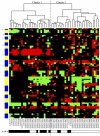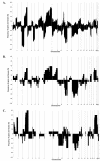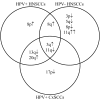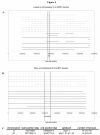Genomic profiling identifies common HPV-associated chromosomal alterations in squamous cell carcinomas of cervix and head and neck
- PMID: 19486517
- PMCID: PMC2698908
- DOI: 10.1186/1755-8794-2-32
Genomic profiling identifies common HPV-associated chromosomal alterations in squamous cell carcinomas of cervix and head and neck
Abstract
Background: It is well known that a persistent infection with high-risk human papillomavirus (hrHPV) is causally involved in the development of squamous cell carcinomas of the uterine cervix (CxSCCs) and a subset of SCCs of the head and neck (HNSCCs). The latter differ from hrHPV-negative HNSCCs at the clinical and molecular level.
Methods: To determine whether hrHPV-associated SCCs arising from different organs have specific chromosomal alterations in common, we compared genome-wide chromosomal profiles of 10 CxSCCs (all hrHPV-positive) with 12 hrHPV-positive HNSCCs and 30 hrHPV-negative HNSCCs. Potential organ-specific alterations and alterations shared by SCCs in general were investigated as well.
Results: Unsupervised hierarchical clustering resulted in one mainly hrHPV-positive and one mainly hrHPV-negative cluster. Interestingly, loss at 13q and gain at 20q were frequent in HPV-positive carcinomas of both origins, but uncommon in hrHPV-negative HNSCCs, indicating that these alterations are associated with hrHPV-mediated carcinogenesis. Within the group of hrHPV-positive carcinomas, HNSCCs more frequently showed gains of multiple regions at 8q whereas CxSCCs more often showed loss at 17p. Finally, gains at 3q24-29 and losses at 11q22.3-25 were frequent (>50%) in all sample groups.
Conclusion: In this study hrHPV-specific, organ-specific, and pan-SCC chromosomal alterations were identified. The existence of hrHPV-specific alterations in SCCs of different anatomical origin, suggests that these alterations are crucial for hrHPV-mediated carcinogenesis.
Figures




Similar articles
-
Genetic patterns in head and neck cancers that contain or lack transcriptionally active human papillomavirus.J Natl Cancer Inst. 2004 Jul 7;96(13):998-1006. doi: 10.1093/jnci/djh183. J Natl Cancer Inst. 2004. PMID: 15240783
-
HPV-ISH-Negative Invasive Cervical Squamous Cell Carcinoma: Histologic and Pap Test Results.Acta Cytol. 2019;63(5):417-423. doi: 10.1159/000500595. Epub 2019 Jun 13. Acta Cytol. 2019. PMID: 31195388
-
Genome-wide DNA copy number alterations in head and neck squamous cell carcinomas with or without oncogene-expressing human papillomavirus.Oncogene. 2006 Apr 20;25(17):2558-64. doi: 10.1038/sj.onc.1209275. Oncogene. 2006. PMID: 16314836
-
HPV Integration in Head and Neck Squamous Cell Carcinomas: Cause and Consequence.Recent Results Cancer Res. 2017;206:57-72. doi: 10.1007/978-3-319-43580-0_4. Recent Results Cancer Res. 2017. PMID: 27699529 Review.
-
Human Papillomavirus Associated Cancers of the Head and Neck: An Australian Perspective.Head Neck Pathol. 2017 Sep;11(3):377-384. doi: 10.1007/s12105-017-0780-7. Epub 2017 Feb 7. Head Neck Pathol. 2017. PMID: 28176136 Free PMC article. Review.
Cited by
-
New Concepts for Translational Head and Neck Oncology: Lessons from HPV-Related Oropharyngeal Squamous Cell Carcinomas.Front Oncol. 2012 Apr 11;2:36. doi: 10.3389/fonc.2012.00036. eCollection 2012. Front Oncol. 2012. PMID: 22655271 Free PMC article.
-
Human papillomavirus infections: warts or cancer?Cold Spring Harb Perspect Biol. 2013 Jul 1;5(7):a012997. doi: 10.1101/cshperspect.a012997. Cold Spring Harb Perspect Biol. 2013. PMID: 23685995 Free PMC article. Review.
-
Predictive value of epigenetic alterations in head and neck squamous cell carcinoma.Mol Cell Oncol. 2014 Oct 29;1(2):e954827. doi: 10.1080/23723548.2014.954827. eCollection 2014 Apr-Jun. Mol Cell Oncol. 2014. PMID: 27308324 Free PMC article. Review.
-
Molecular heterogeneity in human papillomavirus-dependent and -independent vulvar carcinogenesis.Cancer Med. 2018 Sep;7(9):4542-4553. doi: 10.1002/cam4.1633. Epub 2018 Jul 20. Cancer Med. 2018. PMID: 30030907 Free PMC article.
-
Human papillomavirus and genome instability: from productive infection to cancer.Clinics (Sao Paulo). 2018 Sep 6;73(suppl 1):e539s. doi: 10.6061/clinics/2018/e539s. Clinics (Sao Paulo). 2018. PMID: 30208168 Free PMC article. Review.
References
-
- Wilting SM, Snijders PJ, Meijer GA, Ylstra B, Ijssel PR van den, Snijders AM, Albertson DG, Coffa J, Schouten JP, Wiel MA van de, et al. Increased gene copy numbers at chromosome 20q are frequent in both squamous cell carcinomas and adenocarcinomas of the cervix. J Pathol. 2006;209:220–230. doi: 10.1002/path.1966. - DOI - PubMed
-
- Braakhuis BJ, Snijders PJ, Keune WJ, Meijer CJ, Ruijter-Schippers HJ, Leemans CR, Brakenhoff RH. Genetic patterns in head and neck cancers that contain or lack transcriptionally active human papillomavirus. J Natl Cancer Inst. 2004;96:998–1006. - PubMed
LinkOut - more resources
Full Text Sources
Molecular Biology Databases
Research Materials

